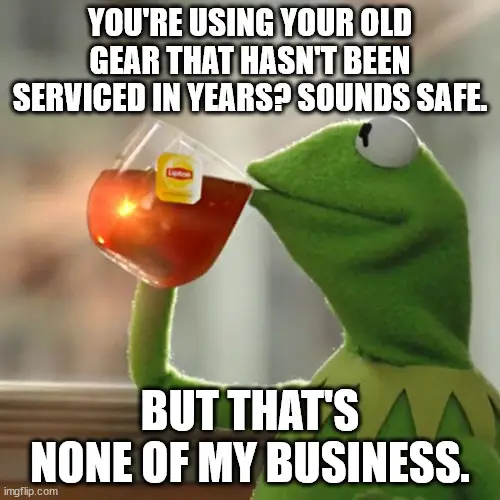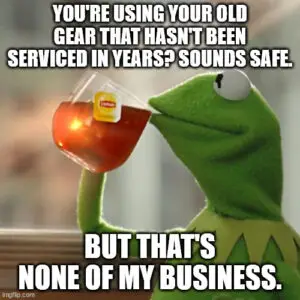1. Why Scuba Gear Maintenance Matters
Imagine this: You’re gearing up for a dive at one of your favorite spots. The water’s clear, the conditions are perfect, but as you descend, something feels off—your regulator isn’t delivering air as smoothly as it should. Suddenly, that minor maintenance task you put off doesn’t seem so minor anymore.
Scuba gear isn’t just equipment—it’s your lifeline underwater. When something goes wrong, it can turn an unforgettable dive into a potentially dangerous situation. That’s why gear maintenance is such a hot topic in the diving community.
How often should you service your gear? Should you follow the manufacturer’s guidelines religiously, or is there wiggle room based on your usage? And what about maintaining your gear yourself—does it make sense, or should you leave it to the professionals?
In this post, I’ll dive into the debate around scuba gear maintenance, share my personal approach to servicing my equipment, and give practical advice to help you decide what works best for you. Whether you’re a seasoned diver or just starting out, keeping your gear in top shape is non-negotiable. Let’s explore how to do it right.
2. The Importance of Regular Scuba Gear Maintenance
Your scuba gear is more than just equipment—it’s the only thing standing between you and the risks of the underwater environment. When you’re 60 feet below the surface, there’s no room for malfunction. That’s why regular maintenance isn’t just recommended—it’s essential.
Here’s why keeping your gear in top shape matters:
Safety First
The most obvious reason to maintain your gear is safety. A regulator that isn’t functioning correctly or a BCD with a leaky inflator can quickly escalate into a serious situation underwater. Regular maintenance ensures that your gear works exactly as it should, giving you peace of mind every time you dive.
Gear Longevity
Your gear is an investment, and regular servicing helps it last longer. Saltwater, sand, and general wear and tear can take a toll, but with proper care, your gear can serve you well for years.
Performance Underwater
Ever struggled with a fin strap that snapped mid-dive or a sticky regulator? Properly maintained gear performs better, making your dives smoother and more enjoyable.
Peace of Mind
Knowing your gear has been inspected, cleaned, and tested by a professional (or by you, if you’re confident in your skills) means you can focus on enjoying your dive instead of worrying about potential issues.
3. What Can Go Wrong Without Maintenance?
Neglecting gear maintenance might save you time and money in the short term, but the risks far outweigh the rewards. Here are some common problems that can arise:
- Regulator Failures: Blockages, worn-out seals, or improper air delivery can turn your dive into an emergency.
- BCD Leaks: A small tear or a faulty inflator valve can compromise your buoyancy control.
- Dive Computer Issues: Dead batteries or outdated firmware can leave you without critical dive data.
- Mask and Fins Malfunctions: Cracked straps or seals can cut your dive short.
4. A Guide to Scuba Gear Servicing
When it comes to keeping your scuba gear in top shape, understanding what needs to be serviced—and when—is key. Whether you’re following the manufacturer’s guidelines or developing your own maintenance routine, here’s a breakdown of the key components and how to care for them.
Regulator
Your regulator is arguably the most critical piece of gear, delivering air from your tank.
- What to Check:
- Hoses: Inspect for cracks, bulges, or wear.
- O-Rings and Seals: Ensure they’re intact and not deteriorating.
- Second Stage: Check for smooth airflow and no leaks.
- Servicing Schedule:
- Manufacturer recommendation: Annual or after 100 dives.
- Personal tip: If you notice restricted airflow, hissing, or a harder-than-usual draw, it’s time for a check-up.
BCD (Buoyancy Control Device)
Your BCD keeps you neutrally buoyant, so a malfunction can turn a great dive into a stressful one. I have seen the most failures and lack of maintenance on this item. From stuck inflators always popping you to the service, to hoses just completely ripping off when you go to dump air. I buy replacement inflators 5 at a time this happens so often around me.
- What to Check:
- Inflator Mechanism: Ensure smooth operation and no leaks.
- Bladder: Look for punctures or wear.
- Dump Valves: Test functionality and clean if necessary.
- Servicing Schedule:
- Annually or based on usage.
Dive Computer
Your dive computer is your underwater guide, tracking depth, time, and no-decompression limits. Dive computer maintenance usually resets the tissue compartments, so plan for this one when you have more than 24 hours before your next dive.
- What to Check:
- Battery Life: Replace batteries as needed, and keep spares on hand.
- Software: Update firmware regularly.
- Display: Ensure the screen is free of cracks and buttons function smoothly.
Exposure Gear
Fins, masks, wetsuits, and drysuits might not be life-support equipment, but they’re vital for comfort and functionality.
- What to Check:
- Straps and Seals: Look for cracks or tears.
- Wetsuits: Rinse thoroughly after dives and hang to dry.
- Zippers: Lubricate regularly to prevent sticking.
Accessories
Don’t forget the smaller items that are easy to overlook but essential for a seamless dive.
- What to Check:
- Dive Lights: Test batteries and bulbs before each dive.
- Knives and Tools: Rinse, dry, and lubricate to prevent rust.
- Surface Marker Buoys (SMBs): Check for leaks or worn valves.
DIY vs. Professional Servicing
Some tasks, like replacing a fin strap or rinsing gear, are easy to handle yourself. Others, like regulator servicing, are best left to professionals unless you’re trained and equipped for the job.
The key is knowing your limits. Routine care and maintenance after each dive can extend the life of your gear and keep it performing well, but never hesitate to consult a professional for more complex issues.
5. My Thoughts on Scuba Gear Maintenance
When it comes to maintaining my scuba gear, I’ve found a balance that works for me. I prefer to handle most of the servicing myself. It’s not always the cheapest or easiest option—the tools are expensive, and sourcing parts can be a hassle—but it lets me work on my schedule and ensures I trust every step of the process.
As someone with a technical background, I take pride in knowing my life-saving equipment is in top condition. After all, many shop technicians are younger, minimally trained, and earning near-minimum wage. While they’re capable, I trust my own attention to detail more for my gear.
That said, I always rely on professionally maintained gear for my students and friends. Liability is a big factor, and I recognize that having a trained, insured technician handle their equipment is the safer choice.
For anyone looking to keep their gear in great shape, here are my quick tips:
- Inspect Often: After every dive, check for obvious signs of wear or damage.
- Rinse Thoroughly: Salt and sand are your gear’s worst enemies—clean them off after every dive.
- Follow a Schedule: Even if you’re not diving often, regular servicing prevents minor issues from becoming major problems.
Ultimately, how you maintain your gear depends on your diving habits, technical skills, and comfort level. The key is to prioritize safety and never ignore a problem, no matter how small it seems.







